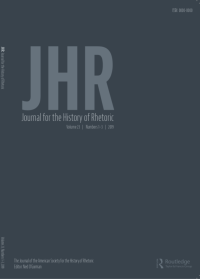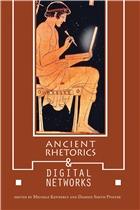Damien Smith Pfister

Associate Professor, Communication
Affiliate Faculty, Classics
Director, Design Cultures & Creativity Living-Learning Program
(301) 405-8988dsp@umd.edu
Prince Frederick Hall 0123
Get Directions
Education
Ph.D., , University of Pittsburgh
Research Expertise
Digital Studies
Rhetoric
Dr. Damien Smith Pfister, Associate Professor of Communication at the University of Maryland, studies the manifold intersections of the rhetorical and the digital. He is the author of Networked Media, Networked Rhetorics: Attention and Deliberation in the Early Blogosphere (Penn State, 2014) and co-editor of Ancient Rhetorics + Digital Networks (Alabama, 2018). Recent essays can be found in The Journal for the History of Rhetoric, The Quarterly Journal of Speech, Communication and the Public, and Philosophy & Rhetoric. A former member of the Board of Directors for the Rhetoric Society of America, Pfister is currently the Reviews editor for Rhetoric Society Quarterly. With Casey Boyle and Michele Kennerly, he co-edits the new Rhetoric + Digitality book series for the University of Alabama Press. Pfister’s current book project is titled Always On: Fashioning Ethos After Wearable Computers, on the rhetorical and cultural implications of wearables.
Publications
Digitality, Diversity, and the Future of Rhetoric and Public Address
Article indicates how theorizing rhetoric and digitality transforms critical and historical traditions.
Author/Lead: Damien Smith Pfister, Carly S. WoodsNon-ARHU Contributor(s): E. Johanna Hartelius & Jessica H. Lu

The pandemic and economic catastrophes of 2020 and the forms of resistance that surged against racist systemic and physical violence indicate, we contend, that studying public address in the present moment requires attention to the mutual contingency of rhetoric and digitality. Relying on interdisciplinary literatures and a global perspective, we direct such attention along three vectors: platforms, commons, and methods. We indicate how theorizing rhetoric and digitality transforms critical and historical traditions. In expanding the purview of the public address tradition while retaining the tradition's hermeneutic potential, we emphasize the need to challenge disciplinary terms and the desirability of expanded analytical methods. We submit that by not attending sufficiently to the advent and diffusion of digital media technologies, public address scholarship misses opportunities to shape ongoing conversations about how rhetoric mediates public affairs; and that insofar as struggles for racial justice are bound up with, not just mediated by, digitality, the prospects of diversifying rhetoric's professoriate increase when research on this topic is central rather than peripheral.
Read More about Digitality, Diversity, and the Future of Rhetoric and Public Address
Digitality, Rhetoric, and Protocological Fascism; Or, Fascist Ants & Democratic Cicadas
Opposed to the ant’s efficiency logics is the cicada, associated with poetic world-making, joy, and mania; the cicada might be recuperated as an icon of democratic renewal, resonance, resistance, and re-enchantment.
Author/Lead: Damien Smith Pfister
Myths about pharmaka are especially useful during dramatic cultural and technical changes. This essay first explores a contemporary myth, Bernard Stiegler’s “Allegory of the Anthill,” as a warning about protocological fascism – the industrialized and undemocratic exercise of control through digital infrastructures. Following Stiegler, I suggest that the algorithms structuring many digital technologies threaten to impose ant-like efficiency logics on subjects, making them more susceptible to the homogenizing political impulses of fascism. If not the logos of the ant, what should we aspire to? To answer this question, I turn to the myth of the cicadas in Plato’s Phaedrus. Lysias, Socrates’ antithesis in the Phaedrus, is associated with an ant-like practical rhetoric that prizes industry over virtue. Opposed to the ant’s efficiency logics is the cicada, associated with poetic world-making, joy, and mania. I argue that the cicada might be recuperated as an icon of democratic renewal, resonance, resistance, and re-enchantment.
Ancient Rhetorics & Digital Networks
An examination of two seemingly incongruous areas of study: classical models of argumentation and modern modes of digital communication.
Author/Lead: Damien Smith PfisterNon-ARHU Contributor(s): Michele Kennerly

What can ancient rhetorical theory possibly tell us about the role of new digital media technologies in contemporary public culture? Some central issues we currently deal with—making sense of information abundance, persuading others in our social network, navigating new media ecologies, and shaping broader cultural currents—also pressed upon the ancients.
Ancient Rhetorics and Digital Networks makes this connection explicit, reexamining key figures, texts, concepts, and sensibilities from ancient rhetoric in light of the glow of digital networks, or, ordered conversely, surveying the angles and tangles of digital networks from viewpoints afforded by ancient rhetoric. By providing an orientation grounded in ancient rhetorics, this collection simultaneously historicizes contemporary developments and reenergizes ancient rhetorical vocabularies.
Contributors engage with a variety of digital phenomena including remix, big data, identity and anonymity, memes and virals, visual images, decorum, and networking. Taken together, the essays in Ancient Rhetorics and Digital Networks help us to understand and navigate some of the fundamental communicative issues we deal with today.
Networked Media, Networked Rhetorics: Attention and Deliberation in the Early Blogosphere
Networked Media, Networked Rhetorics concludes with a bold outline for rhetorical studies after the internet.
Author/Lead: Damien Smith Pfister
In Networked Media, Networked Rhetorics, Damien Pfister explores communicative practices in networked media environments, analyzing, in particular, how the blogosphere has changed the conduct and coverage of public debate. Pfister shows how the late modern imaginary was susceptible to “deliberation traps” related to invention, emotion, and expertise, and how bloggers have played a role in helping contemporary public deliberation evade these traps. Three case studies at the heart of Networked Media, Networked Rhetorics show how new intermediaries, including bloggers, generate publicity, solidarity, and translation in the networked public sphere. Bloggers “flooding the zone” in the wake of Trent Lott’s controversial toast to Strom Thurmond in 2002 demonstrated their ability to invent and circulate novel arguments; the pre-2003 invasion reports from the “Baghdad blogger” illustrated how solidarity is built through affective connections; and the science blog RealClimate continues to serve as a rapid-response site for the translation of expert claims for public audiences. Networked Media, Networked Rhetorics concludes with a bold outline for rhetorical studies after the internet.

